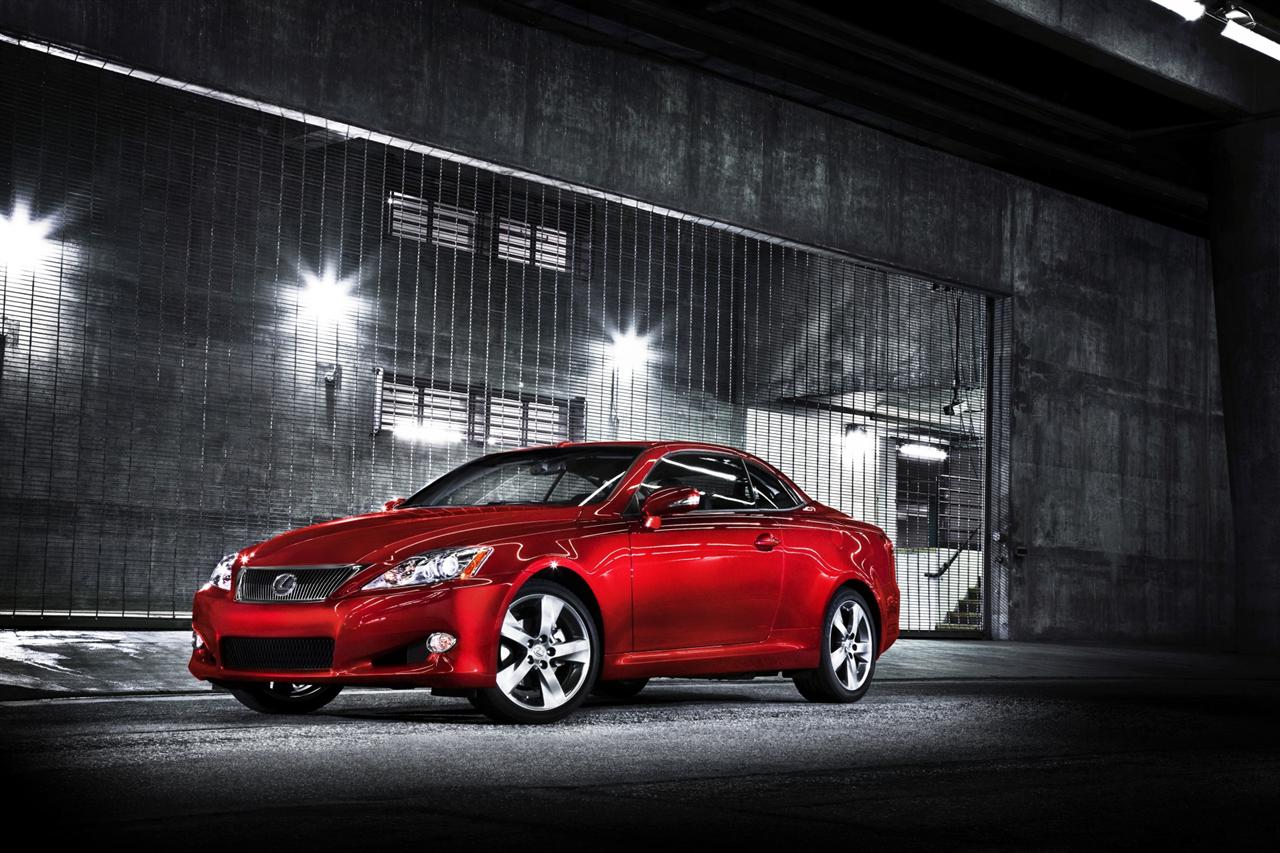2011 Lexus IS 350C Navigation
Toyota's luxury division unveiled its newest sport-luxury compact sedan in 2001, the Lexus IS 300. Sharing its engine with the larger GS 300, the IS was built with rear-wheel drive and carried a 3.0-liter inline 6-cylinder engine that achieved 215 horsepower. The engine operated with VVT-i. During its first season, only a five-speed automatic transmission was offered, but it did incorporate Formula One-inspired E-Shift gear selection on the steering wheel. The wedge-shaped IS body had a semi-fastback roofline and was sharp-edged in design. It was called a 'condensed high-performance stance' by Lexus. A choice of either 16 or 17 inch wheels could be mounted on the IS 300 and front-side airbags were installed along with antilock braking and traction control. Available on the vehicle was a limited-slip differential. Inspired by sport watched, a chronograph-style instrument panel was installed in the vehicle. The IS 300 was originally designed for the European market, and is promised to give 'compelling challenge' to European sport sedans. Though smaller than the BMW, the Lexus IS300 carried a fairly tight rear seat, though it had a high level of comfort. In Japan, the Lexus IS300 was sold as the Toyota Altezza. Introduced in 1999, the IS 300 went on sale in June of 2000. Shortly afterward, it appeared as the CART Championship pace car. Along with the IS 300 SportCross, a five-speed manual-transmission version was debuted. The sedan and the little-known SportCross was somewhat publicized by two racing entries in the 2001 Grand-Am Cup North American Street Stock Series. Competitive immediately, the IS scored its first pole position in its fourth race and first race win in the fifth round at Virginia International Raceway. In March 2003, the IS SportDesign was introduced, basically, a cosmetic package equipped with a special grille, tailpipe along with other touches. Sharing its in-line six-cylinder engine with the Supra, the Lexus IS 300 came with rear-wheel drive and an interior that was more sport than luxury. 215 horsepower was produced with the six along with 218 lb-ft of torque that used variable valve timing to broaden its torque curve. The IS 300 also had a two-stage induction system along with a two-way bymass muffler that enhanced breathing and lower noise. Excellent handling was provided by a double wishbone suspension.
Wind noise was lowered due to a low 0.29 coefficient of drag, while the interior was quieted with sound-dampening asphalt sheets in the roof. Optional on sedans was a real spoiler, while the SportCross featured a unique spoiler as standard equipment. The IS300 had drilled aluminum pedals with rubber pads, supportive height-adjustable seats and stainless steel doorsill scuff plates. 17-inch wheels, low-profile performance-tread tires, auto-dimming side and rearview mirrors, a high-power audio system with both a cassette player and six-disc in-dash CD changer with eight speakers, and High-Intensity Discharge headlights were all standard features.Optional on the IS300 was eight-way power driver's and passenger seats, heated front seats and a power moonroof. The interior could be outfitted with an optional leather/Alcantara trim package or a full leather-trimmed interior in either ivory or black. The SportCross offered the Vehicle Stability Control system as an option. This was also optional on the automatic sedan. This feature was helpful in controlling traction while cornering on slippery or dry road surfaces by utilizing throttle intervention. To help limit rear-wheel slip on acceleration the VSC supplements the standard full-range traction control. Brake Assist and Electronic Brake force Distribution was featured on the four-sensor, four-channel anti-lock brake system. To determine if the driver is attempting emergency braking, brake assist is designed to figure this out, along with if the driver has not stepped firmly enough on the brake pedal to engage the ABS. The system supplements the braking power applied until pedal pressure is released.Pretensioners and height-adjustable anchors are incorporated on the front seatbelts in the Lexus IS 300 to help avoid the forces to the upper torso in a serious frontal collision. The SRS, Supplemental Restraint Systems included dual front airbags, side curtain airbags for the driver and front passenger, and front seat-mounted side airbags. A personal security feature is the speed-sensitive and shift-linked automatic door lock/unlock system.An optional feature on the Lexus IS 300 was the Lexus Navigation System which used a DVD for map storage. All on one disc, the DVD contains all of the U.S. and the major cities in Canada. High-speed route calculation, multi-route calculation, route preview, a dual-map screen mode and simplified highway junction graphics are functions of the Navigation System. Deployed from the dashboard, the System is easily hidden when not in use. The remote controls for the system are hidden in the center console between the front seats. A dashboard storage compartment with a spring-loaded retractable lid is featured on models not equipped with the Navigation System.For 2004 all Lexus IS models added a standard maintenance indicator light along with automatic power door locks. In October 2005, the second generation of IS models were introduced, the IS250 and the IS350.By Jessica Donaldson
When desired, the SportCross and the automatic transmission sedan featured E-Shift steering wheel-mounted shift buttons for finger-tip control over gear shifts. Basically a wagon/crossover version with the same dimensions as the sedan, the IS 300 featured a rear tailgate, a split fold-down rear seatback and fold-down front passenger seatbacks that allowed it to carry either long or odd-shaped items. A rear power outlet and a seatback table were also located in the folding passenger seat.
- 2011 Lexus IS 350C Menu
- Article
- Image gallery
- Specifications
- Recalls
Lexus
Similar Automakers
Similarly Sized Vehicles
from 2011
- Acura RDX
Ariel Atom Mugen
Aston Martin AMR-One
Audi A4
Audi A5
Audi A5
Audi Q5
Audi Q5 Hybrid
Audi S4
Audi S5
Lexus Monthly Sales Volume
September 2024
22,443

















